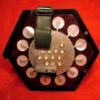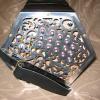Search the Community
Showing results for 'meantone'.
-

Quarter Comma Meantone - What Root Note?
alex_holden replied to Terry McGee's topic in General Concertina Discussion
I've just been doing some experimentation with the tuning app I use (Tonal Energy Tuner for IOS devices), and it turns out that it automatically adjusts its pitch reference in the way that we have been discussing. If you tell it that A4=440 and you want to use quarter comma meantone in the key of G, it actually builds the scale from G4=392 (i.e. an equal tempered G). If I switch it to a different root note, it builds the scale from the equal tempered pitch of that note instead. This app has another useful feature for playing around with alternate temperaments. You can play notes and chords on a virtual piano, and switch back and forth between ET and an alternate temperament with one tap. You can also manually add other temperaments that it doesn't already have in its database (e.g. 1/5th comma MT).- 37 replies
-
- Temperament
- meantone
-
(and 1 more)
Tagged with:
-

Jack Talty In Flow Cd
Stephen Chambers replied to Lawrence Reeves's topic in General Concertina Discussion
Yes, Jack gave me a copy (seeing that I tuned his Eb and B concertinas to 1/5 comma meantone for the album), and I've played it a lot since. -
Two-notes vs. Three-notes chords
Gill B replied to david fabre's topic in General Concertina Discussion
David Fabre Quote"other players playing instruments with different tones and different temperaments" After decades of playing tunes on the anglo by ear, but hating the sound of chords, I am now learning some of the theory (on a need-to-know basis) and experimenting with tunings. In the last year Dave Elliott has been very patient and tuned my even-tempered G/D anglo which I use for sessions; restored an old Jones 22+ button anglo and tuned it to Northumbrian pipe pitch in "just" intonation so that all notes are in tune with the drone; and also restored a 30 button Lachenal to a modified meantone tuning. I still don't like the tuning of the even-tempered G/D. It is very unforgiving, the thirds sound very out of tune to me and chords only sound ok in fast tunes. However there isn't any practical alternative in a mixed session. The only thing that sounds good IMO is piano music! The meantone box is interesting. The meantone system seems to be a clever mathematical concept which sounds fine for minor chords although the fifths are flat, and chords still sound out of tune to me. When I bought the Lachenal C/G it didn't seem to have ever been retuned and the G row was generally 6cents higher than the C row; so it was retuned as close to the original as possible. This means that very good chords can be played by careful choice of the chord shape used. My favourite tuning however, is the old Jones in "Just Intonation". It is now in a sharp Bb with all notes in tune with the drone. It is not responsive enough for fast jigs and reels, but has a beautiful tone for songs and old standards (like "buttons & bows" and "Home on the range".); and of course is perfect for any hurdy-gurdy or pipe tune - with or without the drone. I got a very interesting book a few weeks ago by Ross W. Duffin entitled "How Equal Temperament Ruined Harmony (and Why You Should Care)" . It may have only recently been published in England and makes very informative reading. Only £10 for the paperback. Regards, Gill -
And, it arrived today. This is in Quarter-Comma meantone, A minor (with the addition of a pair of D#s in this bit). I am hesitant to post it because it doesn't do the instrument justice, but here goes anyway... Meantone English Sample (Carpathian Tune)
-
I bought an EC from Geoff Wolfe, and it is tuned in 1/5 comma Meantone based on A. I've a very nice Lachenal tuned Equal Temperament, and the sound difference is quite fascinating. I've become very attached to the meantone tuned instrument. Playing with fiddle or flute I've noticed the players (very good ones) play a bit out of tune for a few moments and then join my tuning. I've yet to have anyone complain about the tuning. I may just have to have Greg J. retune my Lachenal...maybe...
-
Good Question Andy. Short answer; as a 'mender' do you really need to know ? Long answer; the scales on an English Concertina run evenly left hand- right hand-left hand- right hand for the keys of Eb,Bb,F,C,G,D,A and E. Without the repeated Ab/G#'s and Eb/D# this equal handedness would be curtailed by one key at each end of this range. If you are playing in the flat keys you use Ab and Eb and for the sharp keys you would use G# and D#. Perhaps this explaination is a little simplistic and refers to a starting point default fingering which may need to be reversed in more complex musical pieces. For Chording and making Appegios on an EC it is most usefull to have these reitterated notes.Many simple chords can be triangulated and paterns stay logical longer. If one starts a scale on any button and then presses the next button(for the next note up or down the scale) in the centre two rows on the oposite hand (natural notes), if it is the right note then fine, if it is not then press the button next to the one that you feel is wrong (on the corresponding outer row) it will be the correct note unless you are in a key beyond the range stated above.Again without the repeated buttons this patern would not work over the range stated above. For Meantone tunings which would curtail the range of available 'good' key signatures on a Keyboard instrument, these repeated notes (G#/Ab and D#/Eb) can be tuned differently to allow more Keys to be used. An EC in Meantone tuning will sound sweeter than one in Equal Temperament except in very unusualkeys such as B,F# and C# majors.
-

What Accompanies A Concertina Well?
Anglo-Irishman replied to Priscilla's topic in General Concertina Discussion
Michael, This may have some connection withe the topic of equal temperament and meantone tuning that's going on in the "Construction and Repair" section. Modern concertinas are fixed in equal temperament, but the intonation of the fiddle is defined only by the fingers of the fiddler, which are guided by his ear. And in the couple of keys that fiddlers play in, the sound is more "naturally" pleasant when the intervals are NOT equal. The only fixed notes on a fiddle are the open strings, and because of the way a fiddle is tuned (A string tuned to an external source, then the adjacent strings tuned until there are no "beats" when they're bowed together) the open strings are a perfect fifth apart - and equal temperament has imperfect fifths. The "meantone" fingering of the fiddle sounds more pleasant, so in the case of a conflict the equal-tempered concertina is perceived as "wrong". If concertina and fiddle are played together, the fiddler can and should adapt to the equal temperament. Classical violinists have to do that when they're playing with piano accompaniments or in an orchestra with brass and woodwind. On the other hand, it would be interedting to hear a concertina in meantone tuning playing with a fiddle. Might just be a delightful experience! Cheers, John -
Unless your concertina is tuned to meantone (like a Jeffries in original tuning would be), and then they're half a semitone apart...
-

Tuning Of Old Lachenal English Concertina
Don Taylor replied to banjojohn's topic in Instrument Construction & Repair
Geoff: I am thinking off re-tuning my Peacock Hayden to 1/5 Comma Meantone and I wonder if you can confirm the following. The Peacock (and 46-button Haydens like the Wakker you used to own) are missing the two ET enharmonics Ab for G# and Eb for D# so I think that eliminates playing in Eb and Bb from your list of usable keys: Eb,Bb,F,C,G,D,A and E. The 'Easy-Peasy' keys on the Peacock and 46B Hayden are F, C, G, D, A and E so, if I understand it correctly, 1/5 CM works for all the keys that I am ever likely to be able to play. (As an aside: The 52-button Beaumont from the Button Box does have the Eb's and Bb's on both sides so the key of Bb can be added to the list. But, strangely, there is no D# on the LHS so I think that a 1/5 CM Beaumont would lose E altogether. I would rather have Bb than E, but E could have been retained with one extra button on the LHS). Thx. Don. (Further aside: If I have got this right then it is as if the Hayden layout was designed for 1/5 CM). -
I was recently lucky enough to receive a new baritone anglo made by Colin and Rosalie Dipper. It has 39 buttons in the Jeffries pattern and is in tuned in ¼ comma meantone. It's such a responsive concertina and has such a huge dynamic range, I really feel like a stable boy on a racehorse when trying to control it. Here's another of my fumbling attempts at some renaissance polyphony, the chanson douce memoire, by Pierre Sandrin. https://soundcloud.com/aybee-anglo/douce-memoire-adrian Adrian
-

Dipper Baritone Anglo - Douce Memoire
adrian brown replied to adrian brown's topic in Concertina Videos & Music
Thanks for your friendly comments - here are a few more details about the instrument (and photos!) It has raised ebony ends, 8 fold bellows, and measures 7 1/2 inches across the flat sides. Colin made the reed frames from duraluminium to keep the weight down and despite its size, it's only a bit heavier than my Jeffries FC. It's very air efficient and incredibly air tight, so actually the 8 fold is a bit more than I need, though nice for these long slow pieces where you want to play long phrases between bellows reversals. Bob, 1/4 comma meantone and the fact that some of my concertinas are tuned that way, was mentioned in another post here a week or so ago, and I thought it might be interesting to show how it sounds. To cut a long story short, it means that not all semitones are the equal, favouring certain keys over others and making them sound better in tune. http://www.concertina.net/forums/index.php?showtopic=18796 Here is also the note layout which is my preferred Jeffries 38 layout, + one extra RH button (because there was space!) Adrian Baritone Anglo Layout AB.pdf -

Dipper Baritone Anglo - Douce Memoire
Kelteglow replied to adrian brown's topic in Concertina Videos & Music
Nice tone and playing. What is (1/4 comma meantone) ? Bob -
Geoff, What makes a key "usable" on EC, in meantone? (btw, I think you balked at my table of "number of fifths away from reference" thinking that they were cents deviation; I've since amended the post).
- 44 replies
-
I agree with you here Jody that I would also like to have a chance to hear a concertina tuned to 1/5 comma meantone and make up my own mind as to its use for my purposes; although buying another instrument or having mine re-tuned (less likely) would stretch my finances somewhat.
- 44 replies
-
Great tuning stories there. Sorry for the topic drift, but this seems somehow related, no? Yes, I imagine that the three strings per note in much of the piano range help it sound a bit fuzzy in the pitch department, and that could be part of why the piano seems to blend with other instruments so well. As I play an equal temperament tuned Anglo, obviously with only single reeds per note, my workarounds for the harsh ET sound have been three fold... 1. When I'm playing single line stuff, I often try to vary the dynamics widely, so as to move my pitch about. It is slight in the upper registers, but even up there, louder is flatter and softer is sharper. 2. I try to get messy and dense sometimes with complex arrangements. This can cover up glaring out-of-tune sounds (like thirds) by muddying up the waters a bit. 3. I try to spell chords as widely as possible in the low registers. Rarely do I play low close triads and especially avoid those out of tune thirds. Instead favoring octaves and fifths in the low ranges whenever possible. ---------- Perhaps I should try a sweeter temperament, but I would have to get an additional G/D Anglo instrument (my preferred key) tuned to that to try it out, as I fear that it would not work in all situations and I'm loth to over tune my working instruments. In my musical travels, I seem to play mostly in G, D, A, plus the minors in Em, Am, Bm and modal in A. I do play C and F#m chords and E major and B major material from time to time as well as a few diminished chords. Even though this is a limited chromatic pallet, I wonder if 1/5 comma meantone would sound in tune for me. The only way to find out is to try it. Perhaps I will be lucky enough to get to play one that is tuned that way somewhere down the road.
- 44 replies
-
Ok Jim I gave this a try, much to our dog's disgust, and find C-dim 7 sounds pretty bad in 1/5 Comma with either Eb or D# ... and altogether much more agreeable in Equal Temperament. For a quick listen to a 1/5th Comma Meantone tuned EC.... go to the Tune of the Month sub forum and look for the tune "Fiery Clockface' ( march 2013 )... There you will find my entry linked on page 3 (post 47). I suggest this as I played chords throughout... and it is for the sweetening of chords that I choose an alternative temperament.
- 44 replies
-
I forgot to mention I once read that Giulio Regondi had a concertina in equal temperament to play with a piano, and another in meantone to play with an orchestra...
- 44 replies
-
.thumb.jpg.e5ef9a111c1064c0bbea848f22aab7fe.jpg)
How Good Were The Old Cheapies?
SteveS replied to Stephen Selby's topic in Instrument Construction & Repair
The Aeola in my avatar is one such instrument with non-ferrous reeds - has a lovely warm sound, great for song accompaniment - now I'm thinking of sorting the tuning to meantone (1/5 comma perhaps) -

Repairer In Merseyside
Musical Sore replied to Musical Sore's topic in Instrument Construction & Repair
"definitely in meantone tuning." Well, I haven't had the sounds professionally analysed, and a couple of notes are out of tune, but all the G#s are in tune with each other, all the Ab s are in tune with each other, all the D# s are in tune with each other and all the Eb s are in tune with each other; but the D#s are about a quarter-tone flat of the Eb s and the G#s are about a quarter-tone flat of the Ab s. (It was when I noticed this that I started reading up on meantone tuning). A scale of A major or Eb major sounds noticably wrong if you play the alternative accidentals. The thirds sound purer than the fifths. But I noticed this after reading up on meantone temperament, so this could simply be my ear telling me to believe what I read. The pitch, by the way, is around the Society of Arts pitch of C=530, although the concertina is around 1851 in date. I wouldn't want to have the instrument tuned to modern concert pitch and even temperament - it would seem wrong. I think I'd rather play out of tune with everyone else. (thanks to everyone who has replied to my original message) -

Great Iranian/scottish Player
StuartEstell replied to Chris Ghent's topic in General Concertina Discussion
Actually, I really like relentless repetition in general -- it's the execution of it here that's not to my taste. But just as One Direction are not of my generation, neither is Mr. Amini. And his response to this thread might be (quite justifiably) to paraphrase Pete Townshend in "My Generation" --- "why don't you all just f-f-f-f-fade away..." I'm 40, so to a 20-something I'm a total dinosaur. I don't think this music is aimed at me. And that's fine. While I think there's a lot in what you say about what can sometimes seem like "tradition in aspic" I also see a kind of new orthodoxy forming around what I lovingly call "melodeon jazz chords", which might expand the harmonic vocabulary of the instrument a bit, but once I've heard the piled up minor 7th chords a few times the novelty wears off and I find myself wishing for cleaner, starker harmony. Again, that's just my taste. Stephen -- point taken re: meantone tuning but for Arabic music you're going to need more than just G#/Ab and D#/Eb -- for playing maqqam scales based on C you'd certainly want D half-flat and F half-sharp as well. (Has anyone ever built a microtonal concertina with a full set of quarter-tones?) -

Great Iranian/scottish Player
Stephen Chambers replied to Chris Ghent's topic in General Concertina Discussion
The challenge with Arabic music is that many of the maqqam scales involve quarter-tones and other microtonal intervals. I was singing with a Pakistani harmonium player the other day and the semi-classical songs we were working on sounded equal tempered to me, though I could be mistaken. Jody, agreed, what might be loosely termed the Indian classical traditions are generally equally tempered, especially when a harmonium is involved. There are in theory 22 steps to the scale but my understanding is that these are mostly expressed through inflections of bent strings, and the average sitar or sarod player thinks in terms of the same 12 chromatic steps that we do. Arabic music is rather different -- there are quarter tones all over the place. Here's an example in maqqam Jiharkah on this page, where the upper part of the scale has 3/4 tone intervals: http://www.maqamworld.com/maqamat/ajam.html#jiharkah I'll just mention that the English concertina was designed to play a 14 note scale (as were some organs, that have split accidentals) and I sometimes tune them (fifth comma meantone) that way, with half-a-semitone difference between both D# & Eb and G# & Ab (which would otherwise be "wolf notes" in that temperament)... -
You can get a 'real' concertina sound using Thumbjam on an IOS device (iPhone, iPad, iPod Touch) using Michael Eskin's excellent concertina instrument samples. You will have to create your own 'scale' for the meantone temperament that you want to try. You do not need a midi keyboard to use Thumbjam. I also have copy of Phil Taylor's baritone EC sound font file (.sf2) that you might be able to use in other midi controllers/DAWs: https://www.dropbox.com/sh/kx6ude5uwzoan15/AAAy6ZJJMRRuwHVxgx16tfDZa?dl=0 But Phil's samples are 5-15 cents out of tune so this may be a problem for you. I have been meaning to create a new sound font file using some re-tuned samples. I will try to do that this week-end and I will put that into the same drop box folder.
-
Thanks Sam! the mellow sound is because of the beautiful voice of my Jacinta, she has a bit special tunning, the name is 1-5 comma meantone, as Geoff Woof told me. And the speed maybe is a bit excessive, I would have made less mistakes if I had played the tune a bit slower... sometimes when I play it alone I get it better, but I was getting tired of repeating the recording! Fernando So nice to here Jacinta being played with enthusiasm again, after sitting in her box for nearly a year due to other concertinas having entered her domain. Yesterday I discovered a new name for that type of tuning, it is also called "Homogeneous Meantone". I am so glad she has gone to you Fernando, best wishes, Geoff. PS nice tune Chris!
-
This is all true, but it comes sort of automatically, due to the fact that meantone tunings make most sense on diatonic instruments. If you have a D/G instrument, you won't be playing anything in C, so taking F or C as your starting pitch wouldn't make any sense, quite apart from the musical genre you'll be playing. And with an Bb/F instrument, you won't be playing with D-G-centric traditionalists, so Bb as your starting pitch won't be an issue. The instrument should simply be "meaned" to its own keys. Agreed, but my understanding, at least at the beginning of the discussion, was that we were discussing EC here. You're spot on with anglos, and could make a good argument for using meantone with them (at least to me!) As to autoharp: I think you are right there too. But, with a chromatic harp the issues still exist. Of course that may be part of the reason most pros play diatonic harps.
-
This is all true, but it comes sort of automatically, due to the fact that meantone tunings make most sense on diatonic instruments. If you have a D/G instrument, you won't be playing anything in C, so taking F or C as your starting pitch wouldn't make any sense, quite apart from the musical genre you'll be playing. And with an Bb/F instrument, you won't be playing with D-G-centric traditionalists, so Bb as your starting pitch won't be an issue. The instrument should simply be "meaned" to its own keys. This is why the meantone topic is so important with autoharpers. The basic strum of a major triad always results in root-third-fifth-root-third-fifth... sounding in one or two octaves. So even less musical listeners perceive any disharmony. It takes pretty advanced technique to omit the third or the fifth from a chord, should one of them be "sour", so optimal tuning is a must with the autoharp. As concertinists, we can omit any sour intervals at will, just by omitting to press the relevant button combination. Cheers, John







